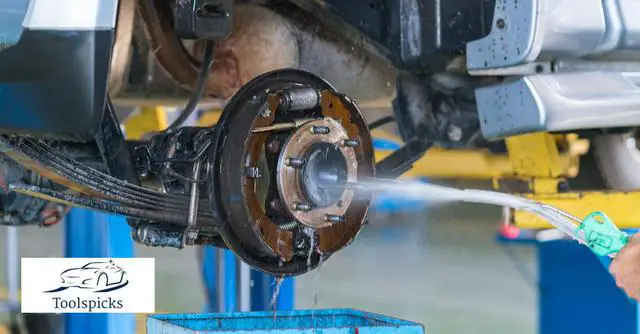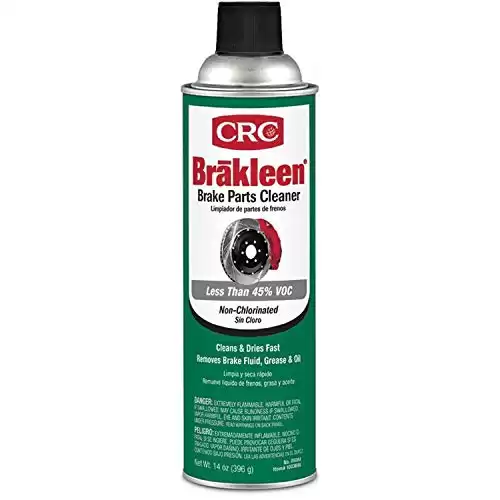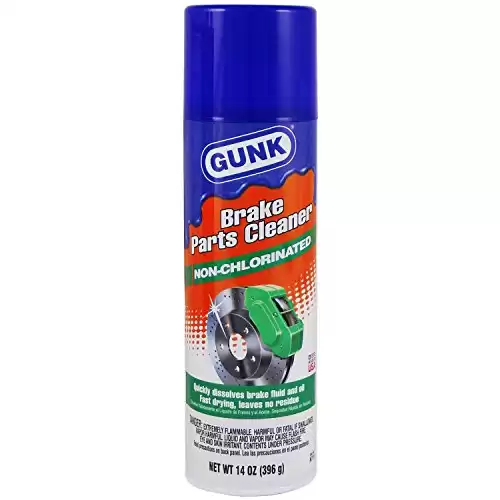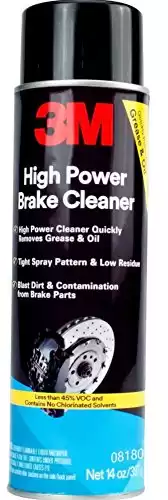Having a high-quality brake cleaner from time to time is a cost-effective method of ensuring that your brakes remain in top condition.
Brake parts cleaner can prolong the lifespan of your brakes by removing dangerous debris and grease, oils, and other contaminants that could reduce the lifespan of your brake drums, pads, or rotors. Furthermore, the brake parts cleaner can solve brake squeals by eliminating the debris accumulated in the brakes.
Additionally, cleaning the brakes can be a simple task done in the comfort of your driveway or garage. Most brake parts cleaners are made to penetrate the brakes, so it isn’t necessary to remove your brakes to provide them with a thorough clean.
Our top pick for brake parts cleaners is CRC Brakleen Non-Flammable, but keep reading to find what suits you best and what to consider when shopping for a high-quality brake cleaner.
Best Brake Cleaner Reviews & Recommendations:
1. Best Overall: CRC Brakleen Non-Flammable
The unique formula for CRC Brakleen chlorinated brake parts cleaner remains the most effective. Each bottle is almost 100 percent perchloroethylene and uses carbon dioxide, which is non-flammable.
CRC Brakleen Non-Flammable and CRC Brakleen Pro Series Non-flammable formulations provide the strongest and most fast-drying brake cleaners.
It removes oil film and rust with ease and is quick to apply. It cleans different elements of engines. It can also clean metallic surfaces in an instrument kit or around the home.
They don’t have any paint-destroying Methylene chloride, so it’s safe to use. The Pro Series offers a larger bottle with a larger spray nozzle.
The biggest drawback is the cost; chlorinated blends are generally more expensive than non-chlorinated ones and aren’t readily accessible in every state.
2. Best Value: CRC Brakleen Non-Chlorinated
CRC Brakleen Non-Chlorinated is the best among the best option for brake parts cleaner. It not only cleans fast but dries dry fast as well.
It quickly removes any contaminants accumulated on brake pads, such as brake fluid, grease, and oil. The chlorine-free formula is a good choice in areas where other formulas are not permitted.
The odor isn’t overly harsh. However, it’s a bit more expensive than the others.
3. Runner up: Gunk Non-Chlorinated
If you operate an off-road vehicle or reside in an area exposed to road dirt (like northern regions with harsh winters and salty, nasty roads), The Gunk Brake and Parts Cleaner may be what you seek.
An excellent all-around product that is quick-drying and is compatible with all braking systems.
The chlorine-free design allows it to be used in numerous places. For example, it works on rotors, drums, and linings. It can handle brake fluid, grease, and oil.
Dry quickly and leaves behind an oily residue. However, in this instance, you’ll be able to appreciate the remnants. The film that remains acts as a buffer between your brake pads and rotors, which can help reduce the sound of your brakes. Result? You’ll get clean brake parts and a quieter journey.
The setback: It could cause some issues if it comes in contact with the painted parts of the vehicle.
4. Honorable Mention: 3M High-Power Brake Cleaner
3M is an incredibly well-known name for car repair and maintenance products. From tapes and glues to brake cleaners, 3M is covered with every chemical you’ll need to keep your vehicle in top shape. the 3M High-Power Brake Cleaner is a fantastic product with many advantages.
First, and evidently, it performs well in cleaning brake components quickly and effectively. 3M Power Brake Cleaner 3M Power Brake Cleaner dries fast and does not leave a trace.
The container includes a “precision straw” to access difficult-to-reach areas in your vehicle and control your cleaner to the exact spot with precision. The cleaner can quickly dissolve grease, oil, and other road grime you’ll likely encounter on your journeys.
Furthermore, it’s non-chlorinated. This is beneficial for various reasons like it does not damage your respiratory system when used. But we prefer non-chlorinated brake cleaners since they are great for cleansing dirty metal before welding; however, they will not release hazardous gas once you begin welding it as chlorinated products do.
3M’s High Power brake cleaner costs more than our non-chlorinated testers; however, it doesn’t require almost as much product to accomplish the task. Its efficiency may offset its expense. The only drawback is that the chlorinated formula is highly flammable.
Note: most brake cleaners don’t only have to clean your brake components; the cleaners can be used on many different parts. However, it’s always best to keep cleaners away from painted and plastic parts.
Buying Guide:
Why Do You Need Brake Parts Cleaner?
Preventional maintenance: Cleaning off your brakes with a few drops of brake parts cleaner can help stop issues before they begin. The powerful cleaning agents get rid of the buildup and dust that could create high spots on the rotor’s surface and shuddering of the brake pedal.
Liquifies brake dust: The brake pad dust may include trace components of hazardous chemicals, such as lead, cadmium, asbestos, chromium, and mercury. This is why you should not employ compressed air to remove brake dust. Brake cleaners can liquefy and remove brake dust more safely.
Cleans oil and grease: Oils and lubricants can damage your brand-new purchased components. Brake cleaner eliminates oil in a matter of seconds and leaves no trace. Also, clean the brakes when they are put back together to prevent premature brake failures.
Types of Brake Parts Cleaner
Chlorinated brake parts cleaner generally beats blends with non- chlorination. And as it’s usually higher priced, we typically take a couple of cans of the best stuff, along with a hefty budget quality brake cleaner for our initial attack. The used brake components don’t have to be pristinely sparkling, and our Best Value award winner CRC Brakleen Non-Chlorinated Brake Cleaner eliminated brake dust in a matter of minutes.
The formulas with higher non-chlorinated grades did better in our tests; however, they were not comparable to the chlorinated winner. Below are the different kinds available:
Chlorinated Non-Flammable
Chlorinated brake cleaners have potent solvents such as Tetrachloroethylene, methylene chloride, and other organochlorines. This heavy-duty cleaner remove dirt fast, does not leave any remnants, and dries quickly. Chlorinated brake cleaners are not flammable; however, they are only used to clean cool components. Tetrachloroethylene may cause the release of dangerous phosgene gas when it comes into contact with surfaces at temperatures higher than 315°F.
Non-Chlorinated Flammable
This type of brake parts cleaner is less powerful but not less harmful than its chlorinated counterpart and may require a longer drying time. Non-chlorinated brake cleaners use a combination of alcohols and hydrocarbon solvents to accomplish the task. The blends may comprise acetone, hexane, naphtha, toluene, xylene, benzene, and methanol. The majority of the non-chlorinated ingredients in brake cleaners are highly flammable. Be cautious.
Essential Brake Parts Cleaner Features to Consider
Powerful Cleaning
Cleaning is the primary component that any good brake parts cleaner must-have, and different formulations can affect the overall performance. Perchloroethylene, also known as PERC, is the principal ingredient in most chlorinated brake parts cleaner. It’s typically more efficient than alcohol and hydrocarbon solvents in formulations that are not chlorinated. However, they aren’t readily available.
Leaves No Trace
The tiniest amount of oily or greasy residue left on rotors or brake pads could cause significant problems later. The most effective brake cleaners blast away the dusty residue. It dries quickly and doesn’t leave any residue.
Red straw
The majority of brake parts cleaners come with an ordinary red plastic extension straw taped to the bottom of the container. The straw is placed into the cavity of the push nozzle to make the thinner flow cleaner. However, certain brake cleaners come with a small hard plastic nozzle built into the cap. An extension straw is placed into the end or utilized without one.
Size
Its size container differs from one manufacturer to the other. Most brake cleaners are approximately 14-ounce containers.
Other Considerations
Regulators and Rules: Brake cleaner formulas are evolving to meet federal and state standards. The conventional understanding might not apply to the latest formulas, so go over the label and then look over the Material Safety Data Sheet to ensure that you are using the correct product.
Deadly and even more dangerous: Choosing between chlorinated brake cleaner and non-chlorinated is similar to deciding whether to fight a lion or the tiger. Both can kill you and, most likely, through different means. Be sure to buy safety gear alongside.
Parts and Guns: Folks swear by brake parts cleaner to wash every kind of part and gun. However, it doesn’t mean that you can’t swear by it. Chlorinated brake cleaner components might be safe for other parts and firearms, but the solvents for brake cleaners that are not chlorinated can cause damage to the paint, plastics, and even non-brake parts.
Volume Prices: Check the listed quantity before purchasing and determine the price per ounce before buying. A $5 can of premium chlorinated brake cleaner can be cheaper than a can for $2 of a lesser-effective, non-chlorinated brake parts cleaner.
Tips & Tricks For Brake Parts Cleaner
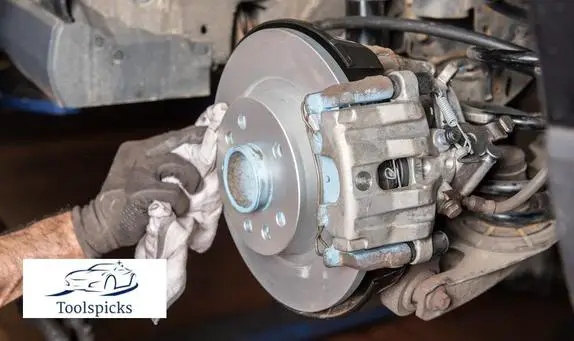
Save money and the environment – Make use of a container and collect the runoff from your brake task. First, soak the brake caliper bolts, rotor shields, and other components in the runoff, then scrub them using a brush. Then, finish the job off by spritzing with a clean cleaner.
Keep cool – do not use brake cleaner on hot or hot parts. Be sure that all brake parts feel cool before using brake cleaner.
Maintenance and inspection – Spray the entire top with quick bursts of spray to get rid of dirt and pad material, leading to chatter and squeaks. Once all brake dust has been removed, it is time to take a closer inspection.
Before packaging, manufacturers treat drums, brake rotors, and other clutch parts with a rust-preventative coat. These coatings should be removed before installation. Brake cleaner eliminates these oils that protect and leaves nothing.
Brake Parts Cleaner Pricing
Under 5 dollars: Numerous brake cleansers fit into this category, and typically, you get what you pay for. It’s not a good idea to pay $4.95 to get the exact amount like the $2.95 can; however, stronger formulas will do the job using less.
5-10 dollars: The decision to invest some extra dollars will get you a higher-quality product and more of it. The premium and mid-priced brake cleaners typically have an impressive cleaning power and a few more pounds in the container and large-volume spray nozzles targeted for success.
More than 10 dollars: The cost of brake parts cleaner vary widely on the internet. A single can of brake cleaner that costs only a couple of dollars at a big box or your local auto parts store could sell for a hefty price on the internet. Buying bulk quantities (or by cases) is a cost-effective option when purchasing online.
Conclusion:
Chlorinated formulas non-flammable like our top-rated CRC Brakleen Non Flammable Brake Cleaner is a well-tested favorite. Purchase it by the case or gallon as long as the law permits the purchase; you’ll save some money. The newer blends that are non-chlorinated are getting better in terms of the formulation; however, availability and formulation differ.
Brake cleaner compliant with VOC or CARB standards for air quality is not necessarily more harmful to human health. The most effective way to find out the contents of the brake cleaner is to look up the material Safety Data Sheet (MSDS) or Safety Data Sheet (SDS). These documents are usually included in the product or can be found by entering the product’s name, brand, and part number, along with MSDS or SDS in your favorite online search engine.
Brake parts cleaner is a vital instrument, and many Shadetree mechanics use it for many purposes. But the truth is that it comes in many kinds. Most of them are dangerous or toxic and flame-resistant. They can also damage things like paint and plastic. So, before you play with it, ensure you’re using the correct item to suit your needs and, if you do, be extremely cautious.

